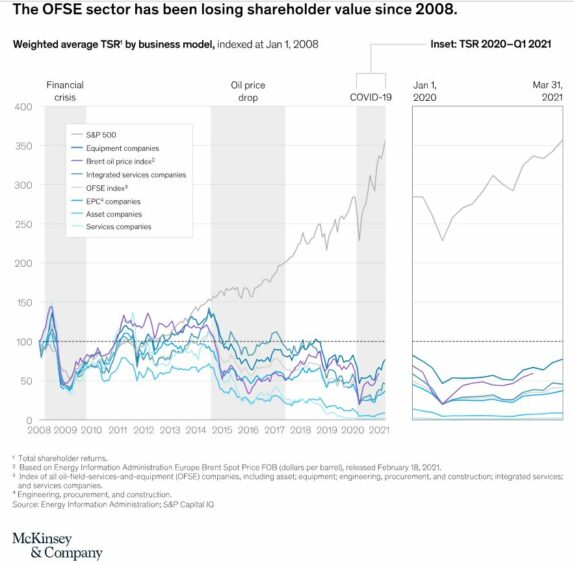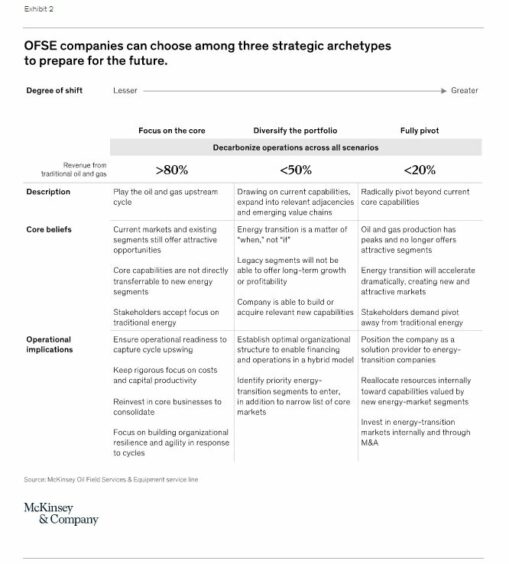
The oil-field-services-and-equipment sector has steadily declined for more than a decade. Companies can consider three broad strategies to revive their fortunes and chart a pathway for the future.
For decades, the oil and gas sector enjoyed sustained growth and prosperity, with great investor returns, some of the largest companies in the world, a raft of impressive engineering accomplishments, and reliable access to the brightest young minds. As commodities, oil and gas follow economic cycles, yet even during downturns, optimism prevailed. The sector—not only explorers and producers but also companies along the entire oil and gas supply chain—simply looked forward to the next upturn and new opportunities to generate more value.
During the past decade, however, a significant and accelerating global energy transition has shaken the industry’s foundations. This article explores implications of the energy transition for the oil-field-services-and-equipment (OFSE) sector, a complex constellation of markets and value chains that operate differently depending on their geographies, business models, and well life cycles. The OFSE sector encompasses more than 40 subsector value chains and more than 100 services delivered by thousands of companies with different business models.
Historical context
The OFSE sector is struggling with a lack of demand for the core services and equipment that sustained its growth over five decades. In the early years, OFSE companies provided capabilities—to construct, complete, and produce oil and gas wells—where none existed.
This was particularly true in the 1970s, when national oil companies (NOCs) were simultaneously expanding and establishing their independence from international partners. In more recent decades, the sector found new demand in post-Soviet Eastern Europe.
Today, however, NOCs and regional companies have gained tremendous experience and built up significant internal capabilities, making them far less reliant on OFSE providers.
OFSE companies also met the industry’s needs during times of explosive growth—for example, by ensuring the security of the supply during Middle East expansion in the 1970s or constructing an agile supply chain during the North American shale boom in the mid-2000s that rapidly drove down cost break-even points. Today, however, markets are oversupplied and growth has plateaued or is declining—a trend that likely will become permanent.
Finally, OFSE companies excelled at driving innovation due to their ability to “amortize” R&D investments across a wide asset base. Until recently, this helped push the boundaries of exploration into, for example, deep-water subsea wells and floating liquefied natural gas (FLNG). Now, however, oil and gas companies’ innovation efforts focus increasingly on optimizing performance—with shorter payback periods—rather than on expansion and growth.
As a result of these market shifts, the OFSE industry saw total returns to shareholders (TRS) decline by 50 percent from 2008 to January 2021; all subsectors experienced declines, though asset companies performed slightly better than services companies (Exhibit 1). During a period when the S&P 500 more than tripled, many OFSE companies fell into bankruptcy. A flood of supply from OPEC+ coupled with a drop in energy demand due to the COVID-19 pandemic has exacerbated the challenges already facing OFSE companies. While the recent upswing in prices creates momentary relief, it does not fundamentally address the sector’s long-term underperformance.

Fundamental market shifts and their implications
As OFSE companies seek new ways to generate value, they will need to address the fundamental shifts taking place in the industry, including slowing demand, improving economics for renewables, an evolving customer base, and changing expectations from capital markets, investors, and other stakeholders.
Flattening demand growth
According to the Reference Case in McKinsey’s Global Energy Perspective 2021, growth in energy demand is likely to flatten as the energy intensity of GDP continues to decline. Projections show demand may peak before 2030 for oil and before 2037 for gas. Although oil and gas still account for a sizable portion of the total energy mix, this plateauing—then declining—demand limits the growth potential of traditional OFSE value pools. A more aggressive accelerated transition, as indicated by recent electric vehicle announcements and rapid hydrogen development, would hasten OFSE-sector decline. As OFSE companies pursue new avenues of growth, emerging energy segments will be prime candidates.
Renewables moving down the cost curve
Renewable-energy technologies including solar photovoltaics (PV) and onshore wind are continuing to move down the cost curve, becoming competitive with traditional energy sources around the world. Renewables will become cheaper than existing coal and gas in many global power markets over the next decade. The levelized cost of electricity (LCOE) of solar has dropped by more than 85 percent over the past decade and is expected to decline further, albeit at a slower pace. Expectations are similar for offshore wind and electricity storage (grid- and industrial-scale batteries).
Meanwhile, the regulatory environment is becoming more favorable to renewables, and public pressure to reduce greenhouse-gas emissions is intensifying. However, significant uncertainty about total demand potential and the pace of adoption of renewable-energy sources complicates OFSE companies’ abilities to evaluate opportunities in their core markets. Market uncertainty not only affects valuations but also makes it challenging to design a strategy and to accurately time investments. Thus, it has never been more important for players to be nimble and proactive.
Evolving customer base
Three important market shifts are driving the evolution of the customer base for OFSE companies. First, independents have tripled their share of global production of liquid fuels, from 5 percent in 1970 to 15 percent in 2020, with a business model that emphasizes low-cost, lean operations. Second, industry consolidation is increasing, with operational excellence as the key value driver. Third, NOCs are continuing to develop internal capabilities and are facing increased cash-generation demands from governments. In aggregate, these drivers are diverting demand from OFSE premium products to unbundled (particularly in areas of low integration risk, such as shale or conventional onshore) and commoditized solutions.
Investments in new energy segments
Oil and gas companies are increasingly looking for growth outside of core markets—diversifying their investments into new energy segments—in response to pressure from investors to increase their terminal growth rates and from stakeholders broadly to combat climate change. The European majors have led the way: Shell plans to increase its renewable-energy capital expenditures to 25 percent of its total capital expenditures by 2025,1 BP aims to invest around $5 billion a year by 2030,2 and Total has announced that it will increase capital expenditures to $3 billion per year by 2030.3
Recent activity also suggests that the relatively greater focus that US majors and NOCs place on their core businesses is changing. In July of this year, Chevron announced the formation of a new unit to manage its low-carbon investments, and in September it pledged to triple its investments aimed at reducing its carbon-emissions footprint through 2028.4 A renewed global commitment to combat climate change will likely lead these and other companies to allocate increasingly larger portions of their capital to new energy segments.
OFSE companies have an opportunity to make up for the decline in spending by core customers operating in traditional markets: they can follow these companies into new and rapidly growing markets. Although they would be targeting new business units, they may have an advantaged position, given their corporate-level relationships and reputations for delivering high quality products. Companies will need to reallocate capital and build new capabilities to make this strategic shift successfully.
Changing investor and capital market expectations
Capital markets and investors are adapting to climate risk and the accelerating energy transition by fundamentally shifting expectations for their portfolios. First, they have increased their focus on immediate cash generation by OFSE companies—a trend that has only intensified as many emerge from bankruptcy. Second, they are discounting terminal value from traditional oil and gas operations.
In this environment, companies will need to strive for operational excellence and maintain healthy cash positions while simultaneously decarbonizing their operations. It is imperative that their strategies, value-creation philosophies, and activities reflect the energy transition and are clearly communicated to all stakeholders. Indeed, these emerging energy segments represent attractive new value pools that could provide the OFSE industry with its biggest growth opportunity going forward.
OFSE strategic archetypes
Given these fundamental shifts, OFSE companies should pick one of three strategic archetypes to form the basis of their strategies. These strategies can, in turn, drive capital allocation, top-line growth, capital efficiency, and potential profitability. Ultimately, the success of a strategy will hinge on a company’s ability to develop sustainable and low-emissions operations, secure access to alternative financing, build new capabilities, transform execution, effectively manage stakeholders, and prepare the organization to embrace the change. OFSE companies should therefore anticipate a multiphase journey to accomplish a strategic shift.
Phase one: Commit to a strategic archetype
The first phase requires a company to align core beliefs about how the future will unfold on a macro level as well as about the company’s fundamental capabilities and positioning within that future context. Doing so will ease the development of an initial strategic ambition and the choice of one of three corresponding strategic archetypes (Exhibit 2).
 Focus on the core. This archetype presumes hydrocarbons will remain an important part of the energy mix for decades to come, requiring oil-field activity that will continue to provide OFSE companies with attractive opportunities (or, at the very least, will counter declining production rates). Companies pursuing this play will need to ensure operational and capital preparedness to capture any potential up cycles and to plan for industry consolidation by positioning themselves to either act as industry consolidators or be acquired by another entity.
Focus on the core. This archetype presumes hydrocarbons will remain an important part of the energy mix for decades to come, requiring oil-field activity that will continue to provide OFSE companies with attractive opportunities (or, at the very least, will counter declining production rates). Companies pursuing this play will need to ensure operational and capital preparedness to capture any potential up cycles and to plan for industry consolidation by positioning themselves to either act as industry consolidators or be acquired by another entity.
Diversify the portfolio. This archetype expects that while hydrocarbons will remain important, growth will stall as the energy transition eventually curtails incremental demand growth or long-term profitability for hydrocarbons. Successful strategies under this scenario hinge on increasing optionality through diversification. OFSE companies will need to correctly identify new energy segments in which they have an advantaged position and reorganize their corporate and business unit structures to enable a hybrid portfolio of hydrocarbons and new energy segments. Companies that pursue this archetype may implement it with wide variations, such as in the level of diversification (for example, as a percent of target revenues or capital reallocation with varying commitments to diversify) or in the maturity of target-market segments (such as relatively mature offshore wind or burgeoning green hydrogen). There are also possibilities in the types of moves made (one or two big bets or a larger number of small bets) and the timing of moves (for example, immediate investments in relatively mature markets, such as solar or wind, versus a long-term plan of investments in nascent markets, such as hydrogen or carbon capture, utilization, and storage [CCUS]).
Fully pivot. This archetype anticipates an accelerated energy transition with oil and gas peaking imminently and limited up cycles in the future. It will be hard to consistently beat the cost of capital, and certain capabilities, such as high-end engineering and R&D, will be better valued in emerging areas. OFSE companies pursuing such a complete portfolio shift will undergo a full metamorphosis into new energy service, equipment, or solutions providers.
There is no universally right choice; each archetype comes with its own challenges, but all have been successfully embraced by companies across industries. However, OFSE companies that opt to fully pivot should reject conventional wisdom that says this path entails simply following the client. Success in new energy markets requires serious effort—including setting a clear focus, developing a robust and coherent transition process, and developing the skills and capacity to deliver—especially as margins are typically lower than in the oil and gas sector.
Phase two: Place your bets
The second phase of the journey entails preparing to identify the market segments—and the investible opportunities within them—to pursue. Possibilities include solar, on- and offshore wind, geothermal, hydrogen, and CCUS, among others. This can be achieved with a three-step iterative process:
- Step one: Complete an intrinsic economic analysis of various potential markets (for example, at the subsegment, detailed value-chain level).
- Step two: Evaluate subsegments (individually and in aggregate) for fit with the strategic archetype.
- Step three: Shortlist the subsegments that align with the company’s core capabilities.
The results of this exercise will have implications on the operating model. Some of the new businesses may need a different structure from that of legacy OFSE businesses, which will require careful tailoring of the organization. For instance, new businesses might depend on close coordination with newer or different stakeholders such as new suppliers, policy makers, and different end customers.
Phase three: Deliver the strategy
Finally, the third phase of implementation can begin: pursuing the organic (for example, create a dedicated business unit) and inorganic (for example, acquire a company) moves required to realize the strategic initiatives and implement the strategy. Successfully delivering the strategy is just as important as creating the right strategy in the first place, if not more so. A forthcoming article will explore this idea further.
OFSE companies face a daunting challenge. While there are several new growth segments to choose from, each has distinct characteristics and a risk/return profile that differs from the others and from traditional oil and gas markets. Moreover, whereas nascent markets such as hydrogen and CCUS are still addressing fundamental questions about underlying technology and ramp-up speed, relatively mature markets such as solar and onshore wind are already getting crowded; hence, they have sharply declining returns.
Overall, the risk/return profile for renewables is still unclear. In less mature markets, venture capital–like returns are possible, but multiple small investments may be needed to get venture capital–style diversification.
If successful, a strategic shift of this magnitude can unlock significant value. But one thing is certain: not all OFSE companies will succeed or even survive. While creating a robust energy-transition strategy is a formidable task, evading or delaying it will certainly be detrimental to long-term success. In a rapidly evolving global energy industry, OFSE companies must act swiftly and pursue an informed strategy. Capital markets have shown that passively riding out the cycle and waiting for the upswing is not an option in the long run.
Recommended for you
